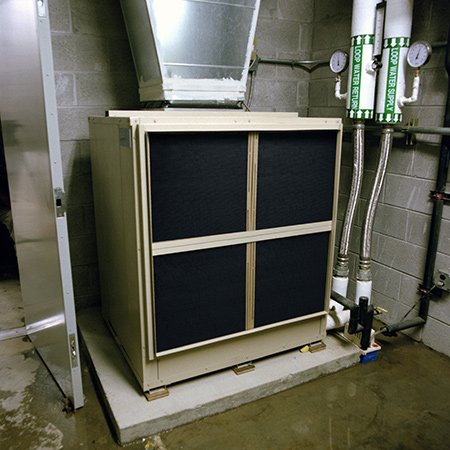- September 14, 2022 / By Admin
Lake Norman Geothermal Heat Pumps

Ground Source Heat Pumps
A ground source heat pump takes advantage of the naturally occurring difference between the above-ground air temperature and the subsurface soil temperature to move heat in support of end uses such as space heating, space cooling (air conditioning), and even water heating. A ground source or geoexchange system consists of a heat pump connected to a series of buried pipes. One can install the pipes either in horizontal trenches just below the ground surface or in vertical boreholes that go several hundred feet below ground. The heat pump circulates a heat-conveying fluid, sometimes water, through the pipes to move heat from point to point.

Credit: Craig Miller Productions, NREL 02409
If the ground temperature is warmer than the ambient air temperature, the heat pump can move heat from the ground to the building. The heat pump can also operate in reverse, moving heat from the ambient air in a building into the ground, in effect cooling the building. Ground source heat pumps require a small amount of electricity to drive the heating/cooling process. For every unit of electricity used in operating the system, the heat pump can deliver as much as five times the energy from the ground, resulting in a net energy benefit. Geothermal heat pump users should be aware that in the absence of using renewable generated electricity to drive the heating/cooling process (e.g., modes) that geothermal heat pump systems may not be fully fossil-fuel free (e.g., renewable-based).
How It Works
The steps below describe how a heat pump works in “heating mode”—taking heat from the ground and delivering it to a building—and “cooling mode,” which removes heat from the building and transfers it to the ground.
Heating Mode
 Circulation: The above-ground heat pump moves water or another fluid through a series of buried pipes or ground loops.
Circulation: The above-ground heat pump moves water or another fluid through a series of buried pipes or ground loops.- Heat absorption: As the fluid passes through the ground loop, it absorbs heat from the warmer soil, rock, or ground water around it.
- Heat exchange and use: The heated fluid returns to the building where it used for useful purposes, such as space or water heating. The system uses a heat exchanger to transfer heat into the building’s existing air handling, distribution, and ventilation system, or with the addition of a desuperheater it can also heat domestic water.
- Recirculation: Once the fluid transfers its heat to the building, it returns at a lower temperature to the ground loop to be heated again. This process is repeated, moving heat from one point to another for the user’s benefit and comfort.
Cooling Mode
 Heat exchange and absorption: Water or another fluid absorbs heat from the air inside the building through a heat exchanger, which is the way a typical air conditioner works.
Heat exchange and absorption: Water or another fluid absorbs heat from the air inside the building through a heat exchanger, which is the way a typical air conditioner works.- Circulation: The above-ground heat pump moves the heated fluid through a series of buried pipes or ground loops.
- Heat discharge: As the heated fluid passes through the ground loop, it gives off heat to the relatively colder soil, rock, or ground water around it.
- Recirculation: Once the fluid transfers its heat to the ground, the fluid returns at a lower temperature to the building, where it absorbs heat again. This process is repeated, moving heat from one point to another for the user’s benefit and comfort.
The above-ground heat pump is relatively inexpensive, with underground installation of ground loops (piping) accounting for most of the system’s cost. Heat pumps can support space heating and cooling needs in almost any part of the country, and they can also be used for domestic hot water applications. Increasing the capacity of the piping loops can scale this technology for larger buildings or locations where space heating and cooling, as well as water heating, may be needed for most of the year.

